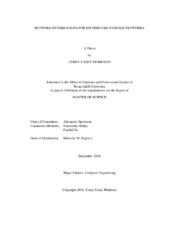| dc.contributor.advisor | Sprintson, Alexander | |
| dc.creator | Morrison, Corey Casey | |
| dc.date.accessioned | 2019-01-18T20:13:04Z | |
| dc.date.available | 2019-01-18T20:13:04Z | |
| dc.date.created | 2016-12 | |
| dc.date.issued | 2016-12-08 | |
| dc.date.submitted | December 2016 | |
| dc.identifier.uri | https://hdl.handle.net/1969.1/174278 | |
| dc.description.abstract | Distributed file systems enable the reliable storage of exabytes of information on thousands of servers distributed throughout a network. These systems achieve reliability and performance by storing three or more copies of data in different locations across the network. The management of these copies of data is commonly handled by intermediate servers that track and coordinate the placement of data in the network. This introduces potential network bottlenecks, as multiple transfers to fast storage nodes can saturate the network links connecting intermediate servers to the storage. The advent of open Network Operating Systems presents an opportunity to alleviate this bottleneck, as it is now possible to treat network elements as intermediate nodes in this distributed file system and have them perform the task of replicating data across storage nodes.
In this thesis, we propose a new design paradigm for distributed file systems, driven by a new fundamental component of the system which runs on network elements such as switches or routers. We describe the component’s architecture and how it can be integrated into existing distributed file systems to increase their performance. To measure this performance increase over current approaches, we emulate a distributed file system by creating a block-level storage array distributed across multiple iSCSI targets presented in a network. Furthermore we emulate more complicated redundancy schemes likely to be used in distributed file systems in the future to determine what effect this approach may have on those systems and what benefits it offers. We find that this new component offers a decrease in request latency proportional to the number of storage nodes involved in the request. We also find that the benefits of this approach are limited by the ability of switch hardware to process incoming data from the request, but that these limitations can be surmounted through the proposed design paradigm. | en |
| dc.format.mimetype | application/pdf | |
| dc.language.iso | en | |
| dc.subject | Distributed File Systems | en |
| dc.subject | Regenerating Codes | en |
| dc.subject | OpenFlow | en |
| dc.subject | Networking | en |
| dc.subject | Storage | en |
| dc.title | Network Optimizations for Distributed Storage Networks | en |
| dc.type | Thesis | en |
| thesis.degree.department | Electrical and Computer Engineering | en |
| thesis.degree.discipline | Computer Engineering | en |
| thesis.degree.grantor | Texas A & M University | en |
| thesis.degree.name | Master of Science | en |
| thesis.degree.level | Masters | en |
| dc.contributor.committeeMember | Reddy, Narasimha | |
| dc.contributor.committeeMember | Gu, Guofei | |
| dc.type.material | text | en |
| dc.date.updated | 2019-01-18T20:13:05Z | |
| local.etdauthor.orcid | 0000-0003-2724-6468 | |


